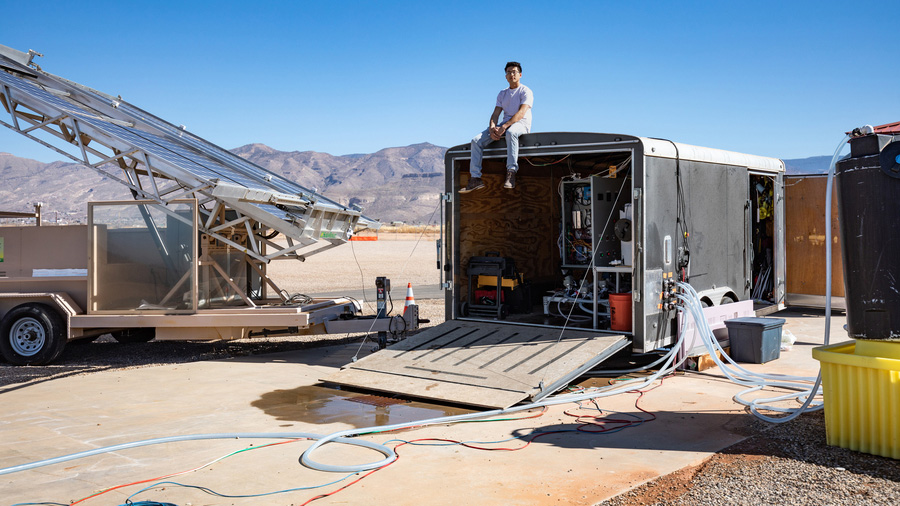Self-Decontaminating Material Destroys Viruses Without Burning Skin
Self-Decontaminating Material Destroys Viruses Without Burning Skin


Newly developed fabric unlocks the potential for reusable personal protective equipment.
As a possible alternative for abundant single-use personal protective equipment (PPE), a team of researchers at Houston’s Rice University have developed a material that can decontaminate itself through heat, all while being worn and without burning the user in the process.
This composite, textile-based material utilizes Joule heating to decontaminate its surface in less than 5 seconds, eliminating at least 99.9 percent of viruses. A study discussing the findings, “Rapid In Situ Thermal Decontamination of Wearable Composite Textile Materials,” was published in September in ACS Applied Materials and Interfaces.
The journey toward this innovation began at the start of the pandemic, when questions arose about the thermal effects on a virus lifetime, if climate played a role, or if home ovens could decontaminate clothing or masks using heat, recalled Daniel Preston, an assistant professor of mechanical engineering at Rice University. To that end, the team received a grant from the National Science Foundation to investigate and learn about virus inactivation in connection to temperature and time.
“With the lack of PPE due to supply chain shortages during the pandemic in mind, we thought, how can we decontaminate PPE so it can be reused?” Preston said. “The lead author of our study, Marquise Bell, had been working on electrically heated textiles for spacesuits as part of his NASA fellowship, and the natural next step was to combine his expertise with our understanding of the thermal inactivation of viruses to create a wearable material that thermally decontaminates itself quickly.”
You Might Also Enjoy: Graphene-based Biosensor Offers Instant Diagnosis
Using electrical current, the newly developed material rapidly heats up on just the outer surface to temperatures above 100 °C (212 °F), but the other side remains close to normal body temperature at a maximum of around 36 °C (97 °F).
“Our material converts electricity to heat, which increases its surface temperature to eliminate viral contaminants quickly and effectively,” Preston explained. “We accomplish decontamination without the user having to take the material off or causing thermal discomfort due to an insulating layer that inhibits this added heat from reaching the user.”
There are safety mechanisms in place so the user won't get burned or feel uncomfortable amounts of heat. In one demonstration, a user wore a garment made with the new material and established electrical connection with a wall-mounted panel via magnetic contacts. Then the electrical system measured the electrical resistance of the material and calculated how much time would be necessary to achieve thermal decontamination after applying electrical heating, allowing safe operation even if the electrical resistance of the material were to change after many uses, explained Bell, a mechanical engineering graduate student at Rice.
“In another demonstration that includes a battery as a portable power supply, we also included a wearable controller that limits the duration of the electrical heating applied to the material to a safe, proven dose,” he said.
Become A Member: How to Join ASME
One of the most significant advantages the new material offers over single-use PPE is reusability. Through vigorous testing, the material proved to be thermally and mechanically durable, able to withstand more than 900 thermal decontamination cycles via electrical heating and showing consistent performance more than 5,000 bending cycles that mimic a finger curling, Bell explained.
“When we compared the amount of waste produced by single-use nitrile gloves to the waste produced by our material in a glove form-factor, we found that we could save more than 20 pounds of waste over the lifetime of our material,” he added.
Although there are some existing thermal decontamination methods for textile PPE, they rely on radio frequency or conventional ovens, both of which required removing the PPE for decontamination, Bell said. Other methods that could be used while PPE is being worn include using embedded heating elements that are either electrical or photothermal, but those processes required minutes or hours to complete. The Rice team’s material can achieve thermal decontamination within seconds, without the need to remove it, he added.
"The biggest challenge we encountered during this project was determining how to accurately relate the temperature of the material to its intrinsic properties and geometry,” he explained. “We already had an idea of how the temperature of the material relates to the amount of virus inactivation, but it took some time to understand how the geometry of the material and its inherent thermal properties relate to the temperature produced on its surface.”
To overcome the issue, researchers implemented a serpentine pattern for the electrically conductive layer and established discrete geometrical parameters that could be used to predict the electrical resistance along its entire length, he continued. “These parameters, combined with the experimentally determined thermal dependence of the resistance, allowed us to relate the geometry of the material to the temperature of its surface during electrical heating,” Bell said.
Try This Quiz: Wearable Technology
A team of seven worked on this effort. In addition to Preston and Bell, doctorate students Te Faye Yap and Zhen Liu, and postdoctoral fellow Anoop Rajappan worked on material fabrication, characterization, and demonstration. Collaborators Kai Ye and Professor Yizhi J. Tao in Rice’s Department of Biosciences then validated the virus inactivation performance.
"We initially thought about just using a larger rectangular-shaped conductive textile, without a serpentine path, to fully cover the entire surface of the material. We then realized the difficulties in uniformly heating larger areas via electrical heating because the electrical current would not flow through the far edges of the material, leading to a non-uniform heat distribution," Bell said. “We pivoted to using serpentine designed paths to effectively distribute the heat more uniformly across the material.”
Next steps will include the extension and experimental validation of the project with other viruses and bacteria, and even translating the work beyond just fabric.
"We’re excited to translate the framework presented in this work relating the material design to its thermal performance, and ultimately to the reaction kinetics involved in virus inactivation, to other commonly touched surfaces like doorknobs or railings for self-decontamination,” Preston said.
Louise Poirier is senior editor.





